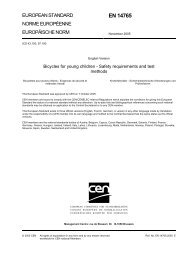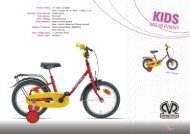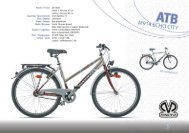EN 14766:2005 - 64_e_stf - Baltik vairas
EN 14766:2005 - 64_e_stf - Baltik vairas
EN 14766:2005 - 64_e_stf - Baltik vairas
- No tags were found...
You also want an ePaper? Increase the reach of your titles
YUMPU automatically turns print PDFs into web optimized ePapers that Google loves.
<strong>EN</strong> <strong>14766</strong>:<strong>2005</strong> (E)4.8.4.2 RequirementWhen tested by the method described in 4.8.4.3 there shall be no visible cracks or fractures in the frame, and thereshall be no separation of any parts of any suspension system.For carbon-fibre frames, the peak deflections during the test at the points where the test forces are applied shall notincrease by more than 20 % of the initial values.4.8.4.3 Test methodUse a new frame/fork assembly fitted with standard head-tube bearings for the test. The front fork may be replacedby a dummy fork of the same length and at least the same stiffness as the original fork.NOTE If a genuine fork is used, failures of the fork are possible, therefore, it is recommended that for convenience, adummy fork stiffer and stronger than the genuine fork is used.Where a frame is convertible for male and female riders by the removal of a bar, test it with the bar removed.Mount the frame assembly on a base as shown in Figure 29 with the fork or dummy fork secured by its axle to arigid mount of height R w (the radius of the wheel/tyre assembly ± 30 mm) and with the hub free to swivel on theaxle. Secure the rear drop-outs by means of an axle to a stiff, vertical link of the same height as that of the front,rigid mount, the upper connection of the link being free to swivel about the axis of the axle but providing rigidity in alateral plane, and the lower end of the link being fitted with a ball-joint.Fit a crank, chain-wheel or chain-wheel set and chain assembly or, preferably, a strong, stiff, adaptor assembly tothe bottom-bracket as shown in Figure 29 and described in a) or b) below.a) If a crank/chain-wheel assembly is used, incline both cranks forwards and downwards at an angle of 45°(accurate to ± 0,5°) to the horizontal and secure the front end of the chain to the middle chain-wheel ofthree, the smaller chain-wheel of two, or the only chain-wheel. Attach the rear end of the chain to the rearaxle and perpendicular to the axis of the axle.b) If an adaptor assembly is used (as shown in Figure 29), ensure that the assembly is free to swivel aboutthe axis of the bottom-bracket and that both replacement arms are 175 mm long (L) and that they are bothinclined forwards and downwards at an angle of 45° (accurate to ± 0,5°) to the horizontal. Secure theposition of the crank replacement arms by a vertical arm (which replaces the chain wheel) and a tie-rodwhich has ball-joints at both ends and which is attached to the rear axle perpendicular to the axis of therear axle. The length of the vertical arm (R c ) shall be 75 mm, and the axis of the tie-rod shall be parallel toand 50 mm from the vertical plane through the centre-line of the frame.Subject each pedal-spindle (or equivalent adaptor component) to a repeated downward force of 1 200 N at aposition 150 mm from the centre-line of the frame in a vertical, transverse plane and inclined at 7,5° (accurate towithin ±0,5°) to the fore/aft plane of the frame as shown in Figure 29. During application of these test forces, ensurethat the force on a "pedal-spindle" falls to 5 % or less of the peak force before commencing application of the te<strong>stf</strong>orce to the other "pedal-spindle".Apply the test forces for 100 000 test cycles where one test cycle consists of the application and removal of the twotest forces.49







